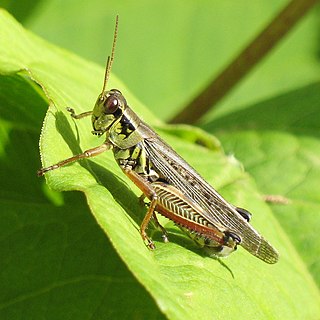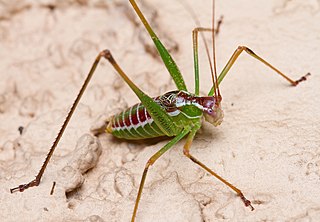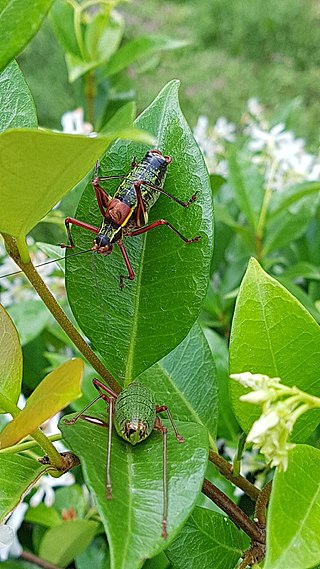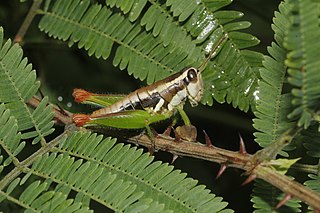
Magnolia is a large genus of about 210 to 340 flowering plant species in the subfamily Magnolioideae of the family Magnoliaceae. It is named after French botanist Pierre Magnol.

The Melanoplinae are a subfamily of grasshoppers in the family Acrididae. They are distributed across the Holarctic and Neotropical realms. They are one of the two largest subfamilies in the Acrididae. As of 2001 the Melanoplinae contained over 800 species in over 100 genera, with more species being described continuously.

Melanoplus is a large genus of grasshoppers. They are the typical large grasshoppers in North America. A common name is spur-throat grasshoppers, but this more typically refers to members of the related subfamily Catantopinae.

Formicivora is a genus of insectivorous birds in the antbird family, Thamnophilidae. These relatively small, long-tailed antbirds are strongly sexually dichromatic. They are found in semi-open habitats in woodland and shrub in South America. They have several rows of white spots on the wings. Males are usually darker below than they are above, and sometimes have a fringe of white on the side.

The cinereous mourner is a species of bird in the family Tityridae. The term cinereous describes its colouration. It has traditionally been placed in the cotinga family, but evidence strongly suggest it is better placed in Tityridae, where now placed by SACC. It is found in Bolivia, Brazil, Colombia, Ecuador, French Guiana, Guyana, Peru, Suriname, and Venezuela. Its natural habitat is subtropical or tropical moist lowland forests.
Cohnia is a genus of Neotropical, sickle-bearing bush crickets in the tribe Odonturini, described by Buzzetti, Fontana & Carotti in 2010.

Heteropriacanthus, the glasseyes or glass bigeyes, are a genus of the bigeye family found in all tropical seas around the world. It occasionally makes its way into the aquarium trade. It grows to a size of 50.7 cm (20.0 in) in total length.

The Phaneropterinae, the sickle-bearing bush crickets or leaf katydids, are a subfamily of insects within the family Tettigoniidae. Nearly 2,060 species in 85 genera throughout the world are known. They are also known as false katydids or round-headed katydids.

Oedipoda is the type genus of grasshoppers, in the subfamily Oedipodinae, mostly from the Palaearctic realm. The type species is the European "blue-winged grasshopper", Oedipoda caerulescens.

Barbitistes obtusus, common name Southern Saw-tailed Bush-cricket or Alpine Saw Bush-cricket, is a species of bush crickets in the subfamily Phaneropterinae.

Aplysina is a genus of sea sponges in the order Verongiida. It was first authenticated and described by Giovanni Domenico Nardo in 1834.

Leptophyes laticauda is a species of bush-crickets belonging to the family Tettigoniidae.
Paraidemona is a genus of spur-throated grasshoppers in the family Acrididae. There are about nine described species in Paraidemona.
Phaulotettix is a genus of Nearctic, grasshoppers in the family Acrididae and subfamily Melanoplinae. There are about 15 described species in Phaulotettix.
Tessellana lagrecai, known as La Greca's slender bush-cricket, is a species of bush-cricket in the family Tettigoniidae. Described by Messina in 1979, the species is found in grasslands and shrublands in Sicily, Italy. It is considered a vulnerable species by the IUCN.

Obolopteryx is a North American genus of katydids or bush crickets in the subfamily Phaneropterinae and tribe Odonturini.

Svercus palmetorum is a small species of cricket, and the sole member of the genus Svercus.

Barbitistes vicetinus, the Vicentine saw-tailed bush-cricket, is a species of katydids crickets in family Phaneropteridae endemic to Italy. The species was originally described by Antonio Galvagni and Paolo Fontana. It is found in vineyards and woody vegetation in the regions of Veneto and Trentino, in particular in the province of Vicenza. In 2016, it was listed as a Near Threatened species by the IUCN due to its restricted geographic range and extreme fluctuations in its population: its current extent of occurrence (EOO) is about 580 km2 (220 sq mi), and its area of occupancy (AOO) is between 50–100 km2 (19–39 sq mi). Formally described as a new species only in 1993, unexpected population outbreaks have severely impacted forests and crops in northern Italy in recent years.

Phaedrotettix violai is a species of spur-throated grasshopper in the family Acrididae. It is found in Mexico and the southern United States.















